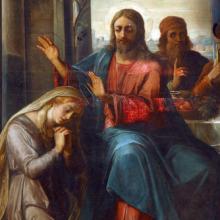female disciples
IN THE OPENING scene of Cecil B. DeMille’s 1927 silent film The King of Kings, a scantily clad but opulently accessorized Mary Magdalene reclines on a lush chaise lounge, caressing a cheetah. She’s an upper-class prostitute, and she learns that Judas, one of her clients, has left her to follow a carpenter. Furious, Mary demands, “Harness my zebras—gift of the Nubian King! This Carpenter shall learn that he cannot hold a man from Mary Magdalene!”
Before she mounts her chariot, someone wagers a purse of gold that she won’t be able to take Judas back from Jesus, because Jesus has magical power to heal the blind. Mary scoffs in reply, “I take thy wager—I have blinded more men than He hath ever healed!”
An angry, haughty Mary finds Jesus, but when he looks at her, she is shaken and steps back. Jesus begins to heal her of seven demons, which emerge one by one from her body like ghosts. After the demons have departed, Mary looks down at her partially naked body, picks up her cloak to cover her skin and hair, then kneels at Jesus’ feet. He pats her head, as if patting a child, and looks away, speaking not to her, but to a man beside him.
I had enjoyed Mary Magdalene’s exotic transportation via zebras, her fury at being scorned, her verbal sparring with the men who doubt her ability to win Judas back. But as I watched the “demons” drain out of her, I felt her life draining too. Now docile and meek, she responds to healing by clothing herself more modestly. The viewer, I take it, is supposed to feel amazed at her transformation. Instead, I felt horror, like I was watching Christianity’s centuries-long suppression of women captured in a 20-second clip, with Mary Magdalene standing in for all of us. The film was silent, but I could hear it speaking to women loud and clear: “Cover up. Lower your eyes. Kneel. Repent. Leave your body and your sexuality behind. Submit. That’s a good girl. You are allowed to belong now.”
Centuries of obsession
WHILE CHEETAHS AND zebras and Judas as Mary’s patron were new adornments to the Mary Magdalene story, the rest of the film’s portrayal was consistent with how Mary has been painted in popular culture for the last 1,500 years: Mary, the prostitute and sinner, turned repentant.
In the earliest accounts, Mary Magdalene is never called a prostitute. Luke 8 says she was healed of demons, but nothing is mentioned about her line of work. It is not until 591 C.E. that Pope Gregory I preaches a sermon calling Mary Magdalene a prostitute, and the misidentification has stuck.
Last Friday was International Women’s Day. It was a day of celebrating how far we’ve come, but also a reminder of how far we need to go.
I’m reminded of an experience I had with a member of my youth group a few years ago. We were volunteering for a social service project. A member of the group happened to be named Eve and we thought it was fun to play up the joke. I’d start greeting people, “Hi! I’m Adam,” and then Eve would chime in, “and I’m Eve!”
We always received the strangest looks, which, of course, is why we did it. But this time it was different. A man at the service project actually said,
“Oh. So you’re the one to blame.”
Eve was able to laugh it off and respond with grace, but I was pissed. I instinctively scowled at the man. It was a deep blow to me because, once again, religion was being used to put women down. But this time it was personal. Religion was being used to put down a member of my youth group.
Of course, religion hasn’t always been good to women. Or, maybe it would be better to say that religious men have used religion as a weapon to make women feel inferior. Whenever we blame someone else it’s a sign of our own weakness and insecurities. We don’t have the courage to deal with our own inner turmoil so we blame someone else. This is classic scapegoating and we men have been scapegoating women in this way since the beginning of human history. It’s pathetic. International Women’s Day is a reminder to me that women and men need to work together to end the religious bigotry against women.
My model for this is Jesus, my favorite feminist. [1]
So, in the spirit of International Women’s Day, I offer you the top 4 ways Jesus included women as full members of his posse.

